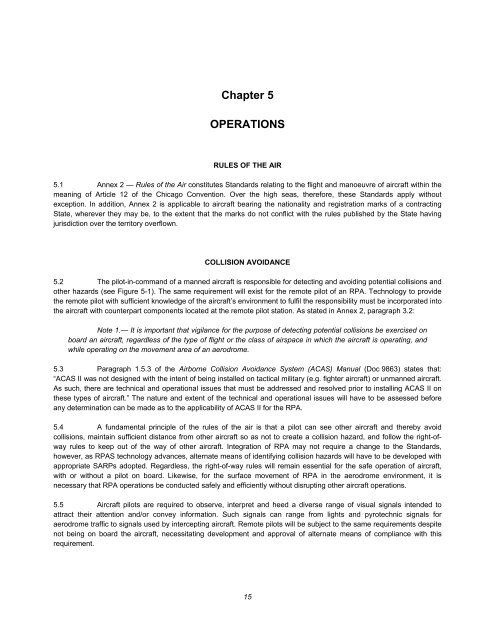Circular 328_en
Circular 328_en
Circular 328_en
You also want an ePaper? Increase the reach of your titles
YUMPU automatically turns print PDFs into web optimized ePapers that Google loves.
Chapter 5<br />
OPERATIONS<br />
RULES OF THE AIR<br />
5.1 Annex 2 — Rules of the Air constitutes Standards relating to the flight and manoeuvre of aircraft within the<br />
meaning of Article 12 of the Chicago Conv<strong>en</strong>tion. Over the high seas, therefore, these Standards apply without<br />
exception. In addition, Annex 2 is applicable to aircraft bearing the nationality and registration marks of a contracting<br />
State, wherever they may be, to the ext<strong>en</strong>t that the marks do not conflict with the rules published by the State having<br />
jurisdiction over the territory overflown.<br />
COLLISION AVOIDANCE<br />
5.2 The pilot-in-command of a manned aircraft is responsible for detecting and avoiding pot<strong>en</strong>tial collisions and<br />
other hazards (see Figure 5-1). The same requirem<strong>en</strong>t will exist for the remote pilot of an RPA. Technology to provide<br />
the remote pilot with suffici<strong>en</strong>t knowledge of the aircraft’s <strong>en</strong>vironm<strong>en</strong>t to fulfil the responsibility must be incorporated into<br />
the aircraft with counterpart compon<strong>en</strong>ts located at the remote pilot station. As stated in Annex 2, paragraph 3.2:<br />
Note 1.— It is important that vigilance for the purpose of detecting pot<strong>en</strong>tial collisions be exercised on<br />
board an aircraft, regardless of the type of flight or the class of airspace in which the aircraft is operating, and<br />
while operating on the movem<strong>en</strong>t area of an aerodrome.<br />
5.3 Paragraph 1.5.3 of the Airborne Collision Avoidance System (ACAS) Manual (Doc 9863) states that:<br />
“ACAS II was not designed with the int<strong>en</strong>t of being installed on tactical military (e.g. fighter aircraft) or unmanned aircraft.<br />
As such, there are technical and operational issues that must be addressed and resolved prior to installing ACAS II on<br />
these types of aircraft.” The nature and ext<strong>en</strong>t of the technical and operational issues will have to be assessed before<br />
any determination can be made as to the applicability of ACAS II for the RPA.<br />
5.4 A fundam<strong>en</strong>tal principle of the rules of the air is that a pilot can see other aircraft and thereby avoid<br />
collisions, maintain suffici<strong>en</strong>t distance from other aircraft so as not to create a collision hazard, and follow the right-ofway<br />
rules to keep out of the way of other aircraft. Integration of RPA may not require a change to the Standards,<br />
however, as RPAS technology advances, alternate means of id<strong>en</strong>tifying collision hazards will have to be developed with<br />
appropriate SARPs adopted. Regardless, the right-of-way rules will remain ess<strong>en</strong>tial for the safe operation of aircraft,<br />
with or without a pilot on board. Likewise, for the surface movem<strong>en</strong>t of RPA in the aerodrome <strong>en</strong>vironm<strong>en</strong>t, it is<br />
necessary that RPA operations be conducted safely and effici<strong>en</strong>tly without disrupting other aircraft operations.<br />
5.5 Aircraft pilots are required to observe, interpret and heed a diverse range of visual signals int<strong>en</strong>ded to<br />
attract their att<strong>en</strong>tion and/or convey information. Such signals can range from lights and pyrotechnic signals for<br />
aerodrome traffic to signals used by intercepting aircraft. Remote pilots will be subject to the same requirem<strong>en</strong>ts despite<br />
not being on board the aircraft, necessitating developm<strong>en</strong>t and approval of alternate means of compliance with this<br />
requirem<strong>en</strong>t.<br />
15


